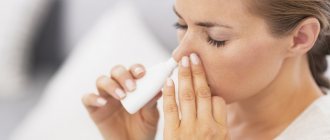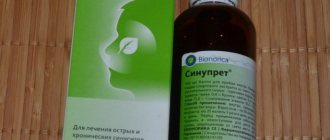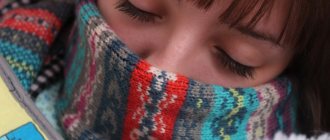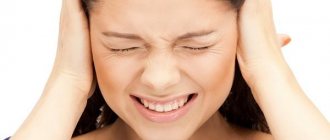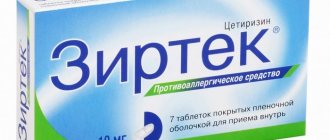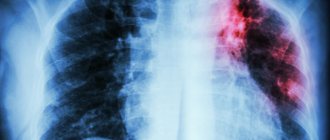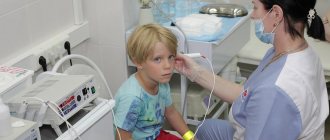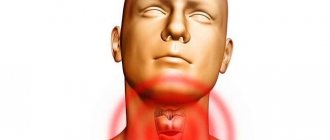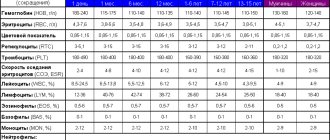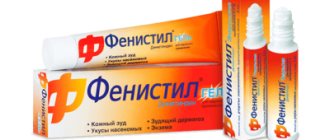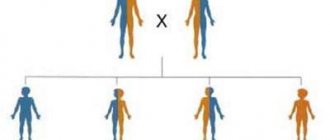Allergic rhinitis is a chronic form of runny nose, which is accompanied by inflammation of the nasal mucosa due to exposure to irritating factors or allergens.
According to WHO statistics, more than 10% of all people on the planet suffer from this disease; the pathology develops mainly at the age of 10-20 years. The disease is often seasonal, the likelihood of relapse increases in spring and autumn, and can occur year-round.
The disease cannot be completely cured, but there are several ways to reduce the risk of another attack. The manifestations of the disease cannot be ignored - a runny nose can lead to the development of complications, for example, triggering asthma or conjunctivitis.
Description of the disease
Allergic rhinitis, or rhinitis, is a chronic disease in which a pathological reaction occurs from the respiratory system upon direct contact with an allergen. In medicine there are several synonyms for this pathology - hay fever, hay fever, allergic rhinoconjunctivitis. The disease is characterized by rapid development; there is currently no effective treatment. There are several classifications of diseases. Basically, allergic rhinitis is divided into:
- seasonal _ Relapse occurs when exposed to seasonal factors (plant pollen, solar ultraviolet radiation, fungal spores and others). The attack continues for several hours after contact with the irritant;
- year-round . Rhinitis can be provoked by a large number of factors (pet saliva, dust, strong odors). The attack lasts several days, the symptoms are less pronounced.
In addition, according to the ARIA classification, allergic rhinitis is divided into intermittent (manifestations more than 4 days a week, up to 4 relapses per year) and persistent (lasts more than 4 days, symptoms are observed from 4 weeks a year).
Depending on the body's sensitivity to the irritant, the first manifestations of allergic rhinitis may occur 1-20 minutes after direct contact.
Drops for allergic rhinitis for children and adults: types and indications for use
A new generation of drops for allergic rhinitis in adults and children can be used based on treatment goals. For example:
- Effective treatment may require vasoconstriction;
- obtaining an antihistamine effect;
- if it is necessary to moisturize the mucous membranes, moisturizing compounds, etc. are used accordingly.
There are several types of anti-allergy drops:
- vasoconstrictors;
- antihistamines;
- homeopathic, moisturizing drops;
- combined drops.
The use of local remedies for allergic rhinitis is possible after consultation with a specialist. After a thorough examination and diagnosis, he will recommend either a specific remedy or prescribe a comprehensive treatment. The patient’s age will also be taken into account, and in the case of examining girls and women, the presence of pregnancy.
Symptoms
Manifestations of chronic allergic rhinitis are varied and depend on the form of the disease, health status and type of disease. Specific and nonspecific symptoms are considered, the severity of which may vary.
Basic
These are typical signs of rhinitis, inherent in any form and severity of the disease. The main ones:
- copious watery discharge from the nose (yellow and green snot);
- itching, burning and paroxysmal sneezing;
- nasal congestion;
- redness of the sclera of the eyes, lacrimation;
- deterioration of smell.
An attack of allergic rhinitis is characterized by a pronounced feeling of discomfort, but against the background of a general deterioration in health, hyperthermia and drowsiness are rarely observed.
Chronic allergic rhinitis
If allergic rhinitis lasts for several days, then inflammation of the nasal mucosa occurs, swelling appears, and all symptoms intensify. Signs of a chronic form of the disease:
- redness and swelling of the wings of the nose;
- hearing impairment;
- conjunctivitis;
- sore throat, coughing;
- sore throat, difficulty swallowing;
- nosebleeds.
If the illness continues for more than 4 days, snoring often occurs during sleep, breathing deteriorates significantly, and the sense of smell decreases. There may be an increase in body temperature due to inflammation.
Read about the symptoms of neurovegetative rhinitis at the link.
Nonspecific
Identifies several signs of the disease that manifest themselves individually and are not typical for allergic rhinitis. Some of them:
- headache;
- sleep disturbance;
- photophobia;
- otitis media, ear congestion;
- weakness and fatigue.
In children, the manifestations of the disease are more acute than in adults. Prolonged course of rhinitis can lead to complete anosmia and anatomical pathologies in the nasal area.
Read about the manifestations of rhinorrhea in this material.
Since allergic rhinitis is provoked by direct contact with an irritant, when the allergen is eliminated, the signs of the disease subside within a few hours.
First generation antihistamines
Fenkarol. The sedative effect of fenkarol is either weak or not manifested at all. Side effects, such as dry mucous membranes, are not characteristic of fenkarol.
Diazolin. This drug also causes little hypnotic effect and has a prolonged (long-lasting, continuing even after drug withdrawal) effect.
Suprastin. The hypnotic effect of this drug is quite strong. Additionally, the drug also has an antispasmodic effect, so it is often used as part of a lytic mixture when it is necessary to quickly reduce the temperature, for example, during an acute respiratory infection.
Tavegil. Among all the drugs in this group, tavegil has the most pronounced antipruritic effect. For bronchial asthma and respiratory infections, tavegil is prescribed with caution or not prescribed at all, as it leads to thickening of sputum.
Fenistil has the mildest effect, which is why this drug is often used in children under one year of age. When applied topically, fenistil (fenistil gel) easily relieves itching and redness characteristic of allergic skin reactions.
Zyrtec - the drug does not have a sedative effect, so it is often prescribed to people whose professional activities require quick reactions - for example, drivers. In addition, Zyrtec has zero drug interactions - that is, it does not interact with any medications, therefore it is most often prescribed as part of complex therapy for diseases - both allergic and infectious.
Claritin. The drug is approved for use in children starting from 2 years of age. It does not cause drowsiness and is considered one of the most effective antihistamines. The disadvantages of Claritin include its ability to create toxic combinations with some antifungal drugs (for example, Nizoral) and some antibiotics (for example, Sumamed).
Kestin. A long-acting drug, well suited for the control of seasonal allergic rhinitis. It is usually started to be used 10-15 days before the expected start of flowering in order to negate the symptoms of allergic rhinitis at the beginning of flowering.
Telfast. This drug is considered safe, as it is quickly eliminated from the body and does not cause symptoms of cardiac arrhythmia, which are characteristic of many second-generation antihistamines. The drug begins to act fairly quickly after use and within an hour after use it relieves almost all symptoms of allergic rhinitis.
Xizal. The effect of the drug begins within 12 minutes after ingestion and lasts for 24 hours after use. Xyzal is approved for use in children over 6 years of age.
Allergodil is a topical antihistamine (nasal spray). It is characterized by a rapid onset of action with very small administered doses. Ineffective for nasal congestion.
Diagnostics
In allergic rhinitis, diagnosis is aimed at identifying the main irritant that triggers an attack of the disease. In addition, the general state of health and specific symptoms are assessed.
The following diagnostic methods are used:
- clinical blood test;
- instrumental otolaryngological methods – rhinoscopy, rhinomanometry, endoscopy;
- hardware procedures – X-ray, CT and MRI;
- allergen test;
- cytological and histological examination of nasal mucus.
The treatment regimen and methods of prevention are selected individually for each person based on symptoms and diagnostic results.
Read about the treatment of allergic rhinitis with folk remedies here.
Treatment
There are no effective treatments for allergies. When this disease is detected, therapy is aimed at eliminating provoking factors and reducing symptoms. For this purpose, medicinal and non-medicinal methods are used.
Medication
This is symptomatic therapy necessary to improve health, normalize breathing and sense of smell. The following medications are used for this purpose:
- antihistamines . They are used to block histamine receptors, which leads to inhibition of the allergic reaction. There is a wide range of such drugs; it is advisable to use only 2nd and 3rd generation drugs that have fewer side effects (Zodak, Claritin, Zyrtec, Telfast);
Read about the use of the drug Allergodil here.
- vasoconstrictor drops . They have a local symptomatic effect, as a result of which swelling and nasal congestion are reduced and vascular circulation is normalized. The effect lasts up to several hours, and the course of treatment should not exceed 10 days, since vasoconstrictor nasal drops are addictive and lead to side effects. An example of such drugs is Naphthyzin, Nazol, Sanorin, Glazolin;
- sprays for washing . Used for children and adults for the treatment and prevention of allergies. Relieves congestion, improves the sense of smell and normalizes mucus production. In addition, the nasal cavity is cleaned efficiently. Popular products - Aqualor, Aqua Maris, Humer;
- hormonal drugs . Intranasal glucocorticosteroids (Flixonase, Beconase, Nasobek, Nasonex) are usually used. They have many side effects, so the course of therapy is limited, the drug is selected only by a doctor. Used to reduce inflammation in complicated allergic rhinitis, when antihistamines do not lead to a positive result;
- enterosorbents . Necessary for removing allergens and toxins from the body, which reduces symptoms and normalizes general condition. They are used in a limited course, as they affect the natural microflora. Effective agents: Polyphepan, Polysorb MP, Enterosgel.
In addition to antihistamines, mast cell stabilizers (Cromosol, Cromoglin, Cromohexal) are also used for allergies. They are taken immediately before contact with the irritant, which reduces the risk of a pathological reaction. Available in the form of a nasal spray or solution for inhalation, which is convenient for symptoms of the respiratory system. Drops are also often used.
The duration of treatment depends on the severity of rhinitis and age. For chronic allergic rhinitis, anti-inflammatory and hormonal therapy is always prescribed to prevent complications.
Non-drug
A large group of treatment methods that are at the intersection of therapy and prevention. It is aimed not only at eliminating symptoms, but also reducing the risk of developing side diseases. Effective non-drug methods:
- Nutrition . They are developing a therapeutic diet that is aimed at solving two problems - reducing the activity of allergens, strengthening one’s own immunity and fortifying the body. It is important to maintain proper nutrition during seasonal allergies;
- Fresh air . Since allergic rhinitis is caused by direct contact with an irritant that is often in the air, it is important to maintain a clean and quality indoor climate. To do this, you need to regularly carry out wet cleaning and use air purifiers;
- Washing . They are used both to eliminate allergens from the nasal cavity and to prevent rhinitis. Irrigation of the nasal cavity is carried out with the help of medicines, homemade compositions;
- Eliminating the allergen. It is first necessary to find out the allergen, and then eliminate it from the environment as much as possible and limit contact. For example, if the allergy is caused by saliva or animal fur, but you should avoid pets.
Eliminating the allergen is a key part of therapy to reduce the severity of symptoms and avoid relapse of the disease.
Allergy treatment borders between symptomatic therapy and prevention. The use of medications is only relevant during exacerbations; the rest of the time it is advisable to limit oneself to non-drug methods to eliminate (eliminate) risk factors and improve health.
Read this article about which pills are best for allergies.
How to use drops correctly for allergic rhinitis
It was noted that the use of this group of drugs for allergic rhinitis is unacceptable without appropriate consultation with a specialist. Especially when home treatment of a child is planned. And also during pregnancy and lactation.
Following the list of recommendations will help you use the drops correctly:
- Before using local remedies, the nose must be rinsed with warm water or a solution. This will help cleanse the passages and sinuses from the causative agent of an allergy or allergen, as well as from viral and microbial organisms;
- After this, you need to take a comfortable sitting position with your head thrown back. You will need to lean slightly to the side;
- then drops are instilled according to the instructions for use. In this case, the previously accepted position cannot be changed within 1-2 minutes after instillation. Similar actions are performed for each nostril separately.
Attention! With prolonged use of remedies for allergic rhinitis, there is a risk of developing addiction. Its consequence may be vasomotor rhinitis.
This is due to the fact that people with rhinitis, driven by advertising, run to pharmacies to buy drops for the common cold. But many names will bring little benefit, suppressing only the symptoms of a runny nose. Getting momentary relief is the main goal of most patients. But if you make the wrong choice and use it chaotically, it becomes addictive.
Prevention
With allergic rhinitis, it is important to know not only how to get rid of the symptoms of the disease, but also how to avoid another exacerbation. To do this, you should follow a number of simple preventive measures:
- Do not open windows completely to reduce the entry of dust and pollen into your home. Use window mesh with small cells or gauze;
- in spring and autumn, do not dry clothes on the street or balcony;
- during seasonal exacerbations, wear sunglasses and a wide-brimmed hat;
- regularly carry out wet cleaning;
- use home air filters, air purifiers;
- monitor the hygiene of the nasal cavity, rinse with sea water;
- exclude allergenic foods from the diet.
Today, homeopathy and specific immunotherapy (hyposensitizing therapy) are used to combat allergies - before the onset of seasonal manifestations, they provoke the body’s reaction to an allergen in a small dose in order to develop resistance. However, this does not always lead to a positive result.
To reduce the entry of dust and pollen into your home, it is recommended to install a carbon air filter on the window. In addition to eliminating the allergen, the device effectively purifies the air from city smog.
Pregnancy and children: how to treat allergic rhinitis “in pregnancy” and in a child
When working with pregnant or lactating women, the doctor primarily takes into account the need to eliminate the allergen. It refers to a microscopic organism that causes the development of pathology.
Attention! Experts do not recommend pregnant women and children to use drops designed to constrict blood vessels. When justified by the stage of the disease and other factors, use may be prescribed. It is also recommended to use antihistamines with caution. This is due to the likelihood of a negative impact on the developing fetus or the fragile child’s body.
Often, for the treatment of a child or mother, including during feeding, the following is prescribed:
- Salin;
- Marimer;
- Aqualor;
- Nasonex;
- Aldecin.
conclusions
- Allergic rhinitis is a chronic form of runny nose caused by exposure to irritants on the nasal mucosa. Occurs through direct contact with an allergen. May be seasonal or year-round.
- The clinical picture depends on the form and severity of the disease. There are specific symptoms (sneezing, nasal discharge, itching and congestion) and nonspecific symptoms - headache, drowsiness, nosebleeds.
- For treatment, drug and non-drug methods are used, aimed at eliminating symptoms and limiting risk factors.
- Preventive measures help avoid allergic rhinitis. To do this, it is important to exclude contact with the allergen and maintain your own immunity.
